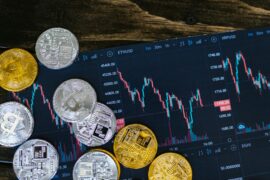This article may contain references to products or services from one or more of our advertisers or partners. We may receive compensation when you click on links to those products or services. Nonetheless, our opinions are our own.
- The Market’s Pulse
- How Tariffs Influence Markets and Investments
- Sector-Wide Implications of Tariff Policies
- Decoding Tariff Structures and Their Impacts
- Types of Tariffs and Their Market Effects
- Investment Strategies in a Tariff-Driven Market
- Positioning a Portfolio for Market Resilience
- Understanding Tariff D-Day and Its Implications
- Key Considerations on Tariff Implementation Days
- Final Thoughts
- Recommended Reads
The Market’s Pulse
As the morning sun glints off Wall Street’s towering steel and glass, a quiet hum of anticipation fills the air. Investors gather, sipping coffee and scanning headlines, eyes flickering over news of shifting trade policies. Tariffs, a force that can sway markets instantly, have once again become the focal point of discussion.
Understanding the impact of tariff changes is essential for anyone navigating the intricate web of global finance. From the pricing of everyday goods to the volatility of stocks, these economic measures shape industries, influence investment strategies, and define market sentiment.
How Tariffs Influence Markets and Investments
Tariffs are more than just economic policy; they are a lever that shifts the balance of trade, production, and corporate profitability. When imposed on imports, they can lead to rising costs, disrupted supply chains, and fluctuating consumer demand. These ripple effects directly affect stock prices, investment strategies, and long-term economic stability.
Sector-Wide Implications of Tariff Policies
The influence of tariffs varies widely across industries. Some sectors may struggle under the weight of increased costs, while others find unexpected opportunities in reshuffling global supply chains.
Key effects of tariffs across industries:
- Manufacturing – A renewed focus on domestic production can drive expansion and investment in local facilities. However, increased material costs may pressure profit margins.
- Retail – Higher import costs often translate to increased consumer prices, potentially reducing demand for non-essential goods.
- Technology – Many tech firms rely on imported components, and higher costs could impact profitability unless supply chains are adjusted.
- Agriculture – Retaliatory tariffs from other nations can cut off key export markets, forcing producers to seek alternative buyers.
- Financial Markets – Stocks react swiftly to tariff announcements, creating volatility that presents both risks and opportunities for investors.
Strategic investment requires a keen awareness of these industry shifts. Investors who anticipate tariff-induced changes can reposition their portfolios to minimize risks and seize emerging opportunities.
Decoding Tariff Structures and Their Impacts
Understanding the mechanics of tariffs is essential for making informed financial decisions. How tariffs are structured can influence businesses and consumers differently, shaping pricing strategies, corporate earnings, and overall market sentiment.
Types of Tariffs and Their Market Effects
- Ad Valorem Tariffs – A percentage-based tax on the value of imported goods. For example, a 15% tariff on a $1,000 product adds $150 to its cost.
- Specific Tariffs – A fixed fee applied per unit, regardless of price. If a $5 tariff is applied to each imported unit, the total cost rises directly to the quantity imported.
- Compound Tariffs – A combination of percentage-based and fixed-fee tariffs, creating a more complex cost structure for importers.
| Tariff Type | Description | Example |
|---|---|---|
| Ad Valorem | Tax based on a percentage of product value | 10% duty on a $200 item = $220 total cost |
| Specific | Fixed charge per unit | $5 per imported item, regardless of price |
| Compound | Combination of percentage and fixed fee | 10% of value + $5 per unit |
These tariff structures affect corporate supply chains and influence consumer behavior, trade negotiations, and geopolitical relationships. Investors tracking tariff adjustments should watch for policy shifts that could alter demand, affect stock valuations, or introduce new growth areas in domestic production.
Investment Strategies in a Tariff-Driven Market
While tariffs introduce volatility, they create new opportunities for those who understand their long-term effects. The ability to anticipate which sectors will benefit or suffer can mean the difference between capitalizing on a market shift and being caught off guard.
Positioning a Portfolio for Market Resilience
To navigate tariff-related risks effectively, consider these investment strategies:
- Shift Focus to Domestic Producers – Domestically manufactured companies may gain a competitive advantage when tariffs make imported goods more expensive.
- Diversify Across Markets – Reducing exposure to industries heavily dependent on imports can mitigate portfolio risk.
- Monitor Supply Chain Adaptations – Firms that restructure their supply chains to avoid tariff burdens may emerge stronger.
- Seek Alternative Investment Avenues – Sectors such as automation and logistics often see increased demand when companies attempt to mitigate tariff-related costs.
By carefully observing policy trends and market reactions, investors can build strategies that are not only defensive but also proactive, allowing them to stay ahead of tariff-induced disruptions.
Understanding Tariff D-Day and Its Implications
“Tariff D-Day” refers to a pivotal moment when new tariff policies are set to take effect. The anticipation surrounding such events often leads to sharp movements in stock prices, adjustments in corporate strategies, and shifts in global trade patterns.
Key Considerations on Tariff Implementation Days
- Market Reactions – Equity markets may experience heightened volatility in response to newly imposed tariffs or trade negotiations.
- Supply Chain Adjustments – Businesses forced to adapt quickly may announce restructuring plans, affecting stock valuations.
- Government Policy Responses – Retaliatory measures from other nations can lead to further unpredictability.
- Consumer Sentiment – Rising costs could influence spending behaviors, impacting earnings reports and long-term growth prospects.
Investors tracking tariff implementation dates should remain vigilant, as swift policy changes can either introduce significant risks or open unexpected investment avenues.
Final Thoughts
Tariffs are an ever-present force in the global economic landscape, shaping trade, influencing financial markets, and redefining investment strategies. While introducing complexity and volatility, they also create distinct opportunities for those approaching them with foresight and adaptability.
Remaining informed about tariff structures, tracking industry shifts, and identifying investment openings can transform uncertainty into a competitive advantage. By maintaining a strategic perspective, investors and businesses can weather market turbulence and emerge more potent in a rapidly evolving financial environment.

Reviewed and edited by Albert Fang.
See a typo or want to suggest an edit/revision to the content? Use the comment form below for feedback.
At FangWallet, we value editorial integrity and open collaboration in curating quality content for readers to enjoy. Much appreciated for the assist.
Did you like our article and find it insightful? We encourage sharing the article link with family and friends to benefit as well - better yet, sharing on social media. Thank you for the support! 🍉
Article Title: Wall Street Brunch: Tariff D-Day Cheat Sheet
https://fangwallet.com/2025/04/06/tariff-market-impact/The FangWallet Promise
FangWallet is an editorially independent resource - founded on breaking down challenging financial concepts for anyone to understand since 2014. While we adhere to editorial integrity, note that this post may contain references to products from our partners.
The FangWallet promise is always to have your best interest in mind and be transparent and honest about the financial picture.
Become an Insider
Editorial Disclaimer: The editorial content on this page is not provided by any of the companies mentioned. The opinions expressed here are the author's alone.
The content of this website is for informational purposes only and does not represent investment advice, or an offer or solicitation to buy or sell any security, investment, or product. Investors are encouraged to do their own due diligence, and, if necessary, consult professional advising before making any investment decisions. Investing involves a high degree of risk, and financial losses may occur including the potential loss of principal.
Source Citation References:
+ Inspo
There are no additional citations or references to note for this article at this time.












































